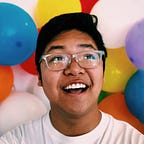“Juicero for water” and other bad takes: brainstorming, sketching, and assumptions mapping potential solutions
Narrowing down our solution space to improve water intake.
From our first-pass intervention study, we learned a lot about what would make an effective solution for our routiners — namely, we needed a way to get them to drink more water throughout the day without making it too disruptive, both physically and mentally.
Tasked with this goal, we set aside a time to brainstorm some solutions.
From our initial 35… 😳
We set aside 5 minutes to brainstorm some ideas, collated them to see where we overlapped, then spent another 5 minutes generating the wackiest ideas possible. Below is our results:
…our top 10 ideas! 🥳
After a quick voting session to get a feel for what solutions we were most excited by, we picked out our top 10 ideas and sketched them out to flesh these ideas out further:
Among these solutions include:
- A passive-aggressive companion app that encourages you to drink water
- A smart bottle paired with a house plant that waters your plant while you drink water
- Juicero but for water, using tech to blend minerals and vitamins in a way that replicates water from parts around the world (hey, not all ideas are good!)
- An app that lets you know when your friends are drinking water
- A Zoom app which uses voice recognition to detect trigger prompts to drink water for
- A water stock market, allowing users to bet on their daily habits
- A hydration arcade that converts water drinking into credits to win prizes
- A text replacement tool that subtly reminds users to drink water
- A drinking game application which uses VR/AR to encourage water intake
- Location-based reminders to drink, using location tracking to trigger alerts
After one more voting session, we narrowed it down to our top three ideas (though we eventually combined two of them into one idea—you’ll see later!).
Text to water 💧
Our first idea that showed promise was an app extension that gradually replaced text on your phone with the word “water” until you’ve logged that you drank a certain predetermined amount. The longer you go without drinking, the more infiltrated your phone will be with “water” (get it? 🤪). We thought that this would be bound to remind people (more than a gentle nudge!) of the importance of drinking water.
From our assumption map above, we observed that there were many important and unknown factors for this solution to work; more problematically, these questions we had were pretty severe, as this lighthearted intervention could be a source of stress or anxiety for our already overloaded routiners. We want this to be a beneficial solution that people will actually use, rather than an annoyance or distraction that does not motivate our users to change their behavior; this concern appeared to be a pretty big roadblock to that.
Hybrid anchors ⚓️
Our other two potential solutions were location-based reminders and a Zoom app which recognized certain trigger words. Not wanting to be tide down to one, we combined these two ideas together for one dam good solution. *groan*
We hoped that this franken-solution would anchor drinking water to activities that they are already doing in their daily life (both physical and virtual), and would trigger a reminder about those anchors using their location or common phrases heard on Zoom.
From our assumption map, we observed that this solution depended heavily on users actively paying attention to Zoom or their phones for the anchors to be beneficial; that’s not always a guarantee, especially when Zoom fatigue is involved. Like the previous idea, there’s still some level of concern over this solution being disruptive rather than constructive in forming this habit — however, we as a team agreed that balancing this concern felt far more attainable than balancing the intrusive water texts.
Next steps 🏃♂️
Ultimately, we’re pretty open to working with any of these solutions — our current preference is the second idea, because it seems to better fit our routiner persona’s need to drink more water throughout the day by creating additional anchors as opposed to asking them to change their day-to-day habits.
